In these lessons, students will learn how to respond to the play not just as a piece of writing, but as a piece of drama. Tasks include: responding to design elements such as set design and music, and creating posters, set designs and other materials to help imagine and bring to life their own productions.
In order to benefit fully from these lesson plans, we recommend you use them in the following order:
- Text in Performance
- Language
- Characters
- Themes
- Contexts
If students are new to the play, we suggest you start with these introductory KS3 Lesson Plans. If you would like to teach the play in greater detail, use the advanced KS4/5 Lesson Plans.
These lesson plans are available in the Downloads section at the bottom of this page. To download resources, you must be logged in. Sign up for free to access this and other exclusive features. Activities mentioned in these resources are available in a separate downloadable 'Student Booklet', also at the bottom of this page. The 'Teachers' Guide' download explains how best to use Teach Shakespeare and also contains a bibliography and appendices referencing the resources used throughout.
Key Questions for Students:
Can I explain what a theatre director does?
Can I show understanding of some factors to bear in mind when casting a play?
Key words: actor, casting, director, rehearsal, production
Prologue: Opening Discussion
Using the Directing Shakespeare PowerPoint (in the Downloads section of this page), students are shown the following series of images from rehearsal rooms where the director is in the shot.
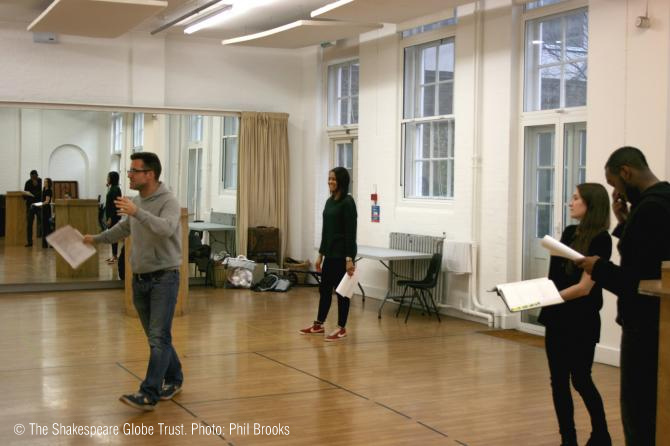
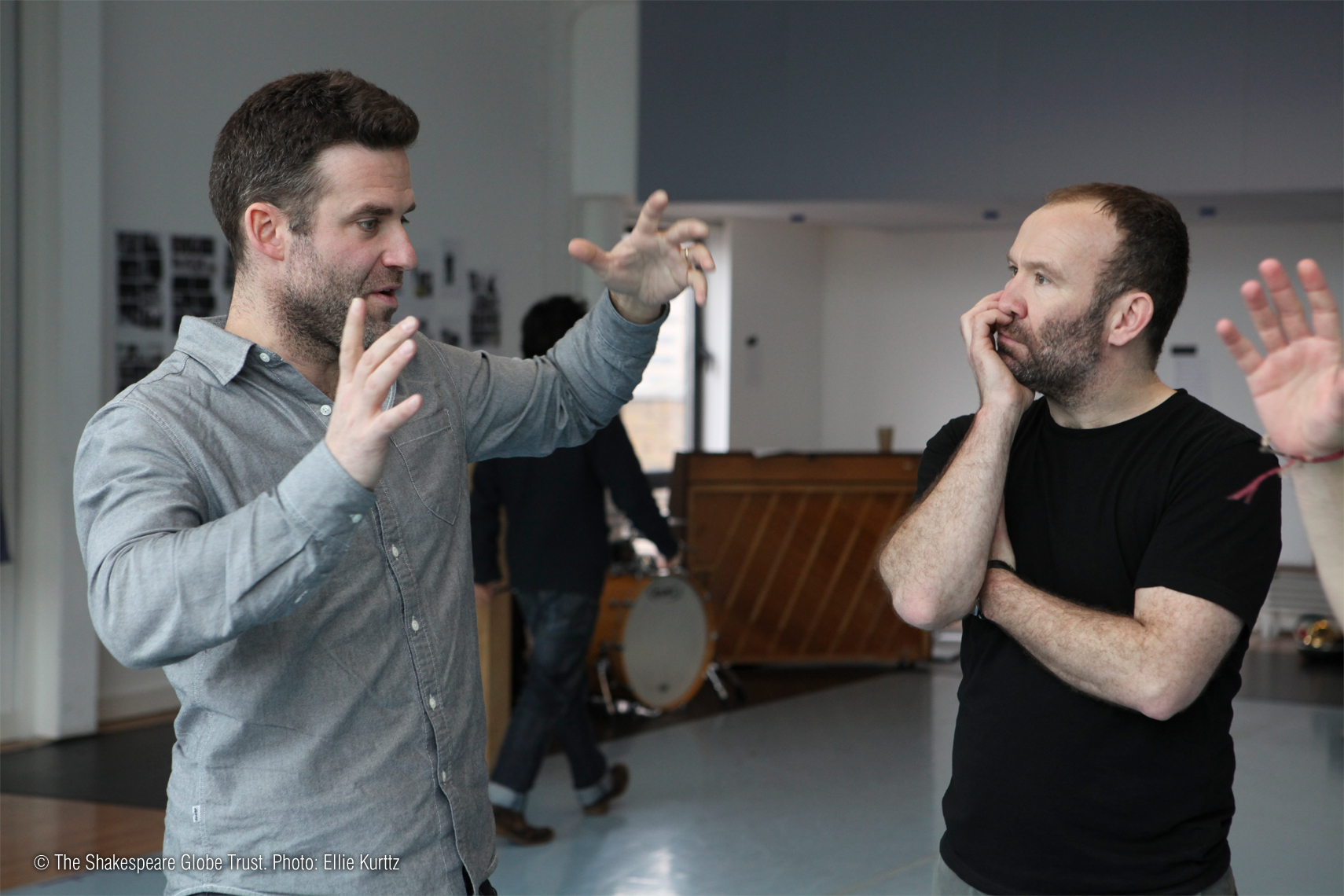
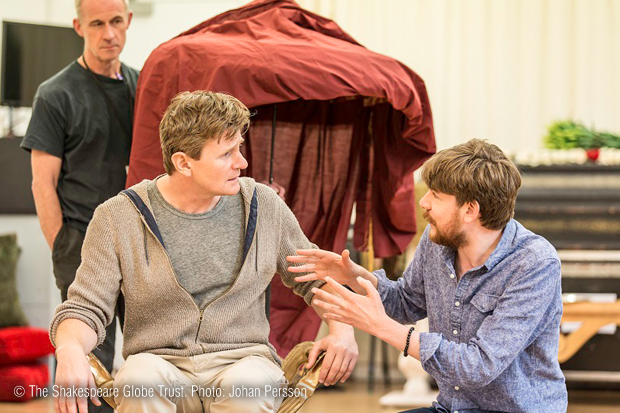
Ask students to discuss for each picture:
- Who is the director?
- Why do you think this?
- What clues do their body language and facial expressions give us about their role?
Now students could be asked to think more broadly about what the job of the director involves. The Globe blog (blog.shakespearesglobe.com) and Playing Shakespeare with Deutsche Bank website (playingshakespeare.org) feature images of directors working with actors in rehearsal which might be used at this point, as well as interviews with directors. Ideas could be captured on one big brainstorm or list and can also then be recorded by students in their Student Booklets.
Enter the Players: Group Tasks
1) Becoming a director
Students could consult two sources in more depth to investigate the role of the director.
- Listen to an excerpt from the Globe Adopt a Director podcast at shakespearesglobe.com/discovery-space/adopt-an-actor/archive/tempest-directed-by-jeremy-herrin. Play this from 1 minute 10 seconds to 1 minute 53 seconds only. Students add key points to their brainstorms.
- Read Rex Gibson’s ‘Guidelines for student directors’ (pp. 183-84) – featured in the Student Booklet – in pairs. Students could summarise each of the nine points Gibson makes in a single word and feedback some examples, before adding their new ideas to their brainstorms.
You could ask a few students to give their ‘top three’ words from their brainstorms that encapsulate the director’s role.
2) Headshots
This activity moves on to the job of casting the play and can be found in the Student Booklet. Give each group one of the main characters from Romeo and Juliet and ask them to consider the attributes and qualities they would be looking for in an actor who plays that part. Students could select two actors they would like to invite to audition for each part and rank them. Some actors may get invited to audition for more than one part!
3) My Dream Cast
Instruct students to turn to the Dramatis Personae page at the start of the Student Booklet. You should mention some of the famous actors who have played the roles of Romeo and Juliet over the years. Ask students to cast the play using any actors they choose from the worlds of TV, film and theatre. Students should give feedback on their casting decisions ensuring that they justify their choices.
Exeunt: Closing Questions for Students
How much does a director ‘direct’ what goes on in a production of a Shakespeare play?
What else does the director do and what skills do directors need?
To what extent and in what ways is a play a collaborative effort?
Suggested plenary activity…
Students write on sticky notes some ideas in the form of ‘director’s notes’ for the actors playing Romeo and Juliet. They could be single words, longer comments or key quotations. Collect these ‘director’s notes’ for use in future lessons.
Asides: Further Resources
- Students can visit the Adopt An Actor archive, which features blog posts and podcasts by actors in previous Globe productions of Romeo and Juliet: shakespearesglobe.com/adoptanactor
- If students are completely unfamiliar with the play at this stage, they can be supported in a variety of ways including: scene-by-scene plot synopsis, quiz, character profile pages, a chance to read or watch a short retelling of the plot. These can be found on the Playing Shakespeare with Deutsche Bank website for Romeo and Juliet: 2013.playingshakespeare.org
Epilogue: Teacher's Note
Students could return to these points about the role of the director throughout their studies, particularly when stepping into the role of director in group work and ensemble performances, etc.
Key Questions for Students:
Can I investigate how Romeo and Juliet has been interpreted by different directors?
Can I think creatively about how I would stage Romeo and Juliet, including where and when I would set it?
Can I design a theatre poster to convey my vision about my production of the play?
Key words: interpretation, music, production, poster, setting, vision
Prologue: Opening Discussion
Students could be shown the following quotation by Globe director Bill Buckhurst about staging Romeo and Juliet:
'What we tried to do, and certainly what I tried to do when I first read it again knowing that I was going to be directing it, was to try and think of it as a new piece of writing as best you can.'
With this in mind, you might ask students to close their eyes as you talk them through a very generalised plot of Romeo and Juliet. This shouldn't refer to people, places or times, perhaps not even to gender, e.g. ‘This is a story about a two teenagers – a boy and a girl – whose families hated each other for generations. They fell in love at first sight after meeting at a party…’ Suggest to students that the action being described could be happening today in their neighbourhood or somewhere far away, perhaps in another time. Encourage students to think freely and creatively and to develop in their mind’s eye a setting that they think might work if they were staging their own production of Romeo and Juliet.
Enter the Players: Group Tasks
1) ‘Give me some music’
Play to students various pieces of music from productions of Romeo and Juliet; these can be from stage or screen versions, for example, Baz Luhrmann’s 1996 production. Ask students to write down what the music suggests to them. Draw out from the feedback how music can suggest a particular mood, a particular setting, or a particular type of activity that is going on.
2) Romeo and Juliet gallery
Provide a gallery of Romeo and Juliet production posters and book covers which could be displayed around the classroom. Ask students to tour the images, making notes in the Student Booklet about what the images show. Students could first of all be asked to stand by their favourite one. They should then discuss in their groups:
- What do the images tell you or suggest to you about the play’s storyline? (especially if they are new to the play)
- What does each image emphasise in particular about the play? (alternative question if students have more prior knowledge)
- Which ideas would I like to borrow or be inspired by when thinking about the mood and setting of my own production?
3) Creative brief: poster
To prepare for this task, students could watch this video of marketing designer Adrian (2013.playingshakespeare.org/week-by-week/73.html). He talks about how a director’s vision for a play is interpreted by the design team who work on a production. Students could also watch this short film that will give them more of an idea about the design ideas that Adrian is talking about in the interview:
Assign students the task of producing a poster for their own production of Romeo and Juliet. The brief and template for this task can be found in the Downloads section at the bottom of this page.
Here are some Top Tips:
- Make it bold so that it immediately grabs the attention of the viewer.
- Be as creative as possible so that it is unique from any competition.
- Make sure that all the information can be read clearly so that no important details about the show are lost.
- Think about who the poster is aimed for and target it for that particular market.
- Consider the subject matter for your poster. You need to research and understand the topic before you begin designing.
Exeunt: Closing Questions for Students
What have I learned about the different ways that directors have interpreted Romeo and Juliet and the different settings they have chosen?
What ideas do I have about staging the play and attracting a young audience to it?
Suggested plenary activity:
Students should share their ideas about staging the play with a partner and listen to their ideas. They should then use their feedback to further develop and refine these ideas; this will assist them with the poster task. Ideas should be creative and perhaps daring, but also coherent.
Asides: Further Resources
- Pinterest or other similar websites could be useful to help students understand the idea of ‘pinning’ ideas to a ‘board’, with their own comments added.
- Students could be shown this short animation from the Globe Playground as an introduction to the poster activity: www.youtube.com/watch?v=dnejfe3CSQY. Other useful videos include the trailers from the Globe’s 2009 (youtube.com/watch?v=8TuR24xhtYg)
or 2015 (youtube.com/watch?v=bW1cJMAMkls and youtube.com/watch?v=veQS0pfAaV8) productions of the play. Which elements of the play are emphasised in each short film?
Epilogue: Teacher's Note
A poster (perhaps accompanied by a spoken or written commentary) could be the basis for a mid-unit assessment.
Key Questions for Students:
Can I identify some of the different opportunities and challenges that set designers face in different styles of theatres?
Can I find out about what the stage looked like in Shakespeare’s time in theatres like the Globe?
Can I imagine how I would create a sense of time and place in my production?
Key words: lighting, set design, set designer, setting, special effects
Prologue: Opening Discussion
The Setting the Scene PowerPoint (available in the Downloads section at the bottom of this page) shows the following set designs from various productions of Romeo and Juliet. Ask students to reflect on the following images in light of what they know about the Globe stage.
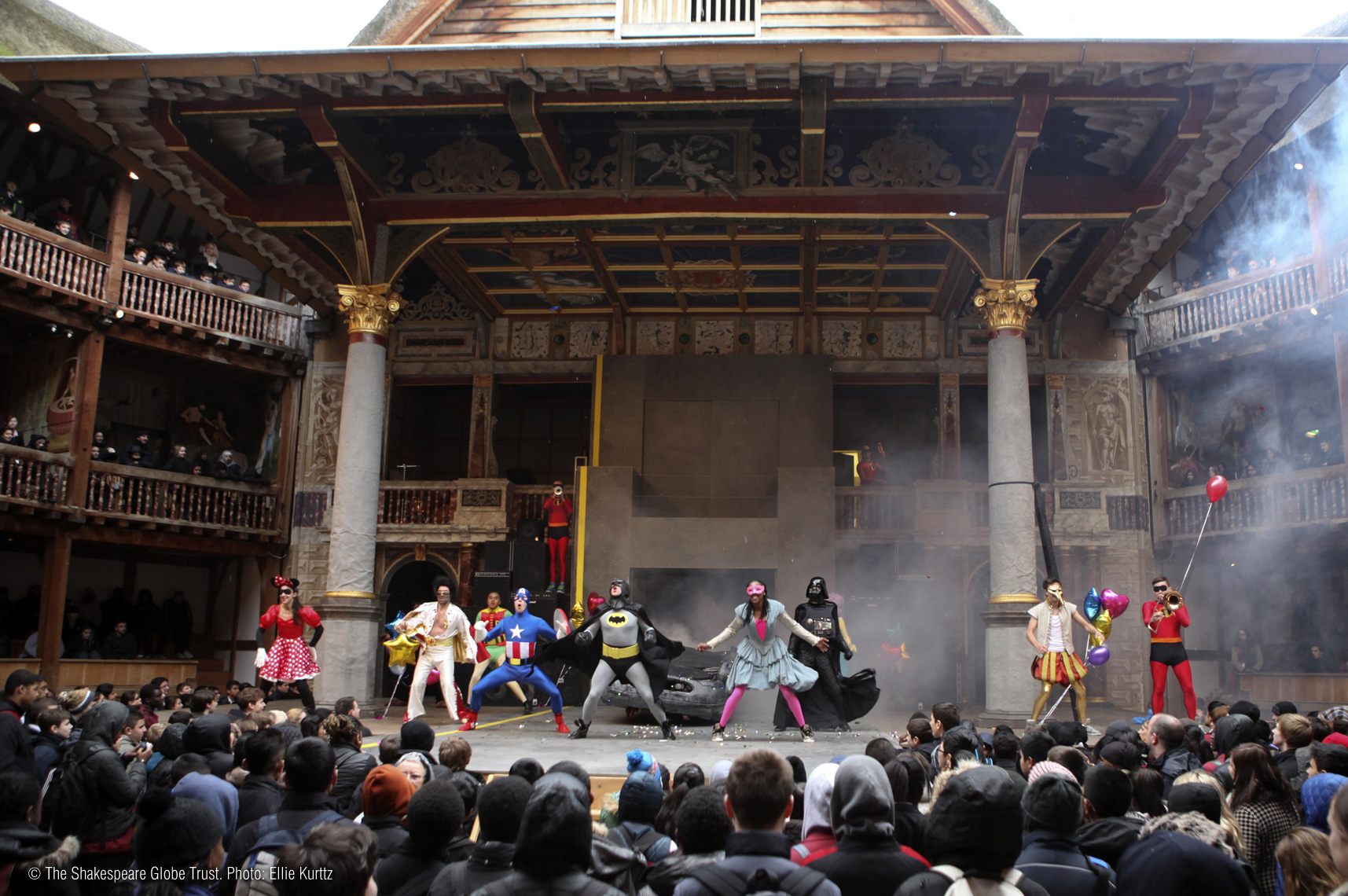



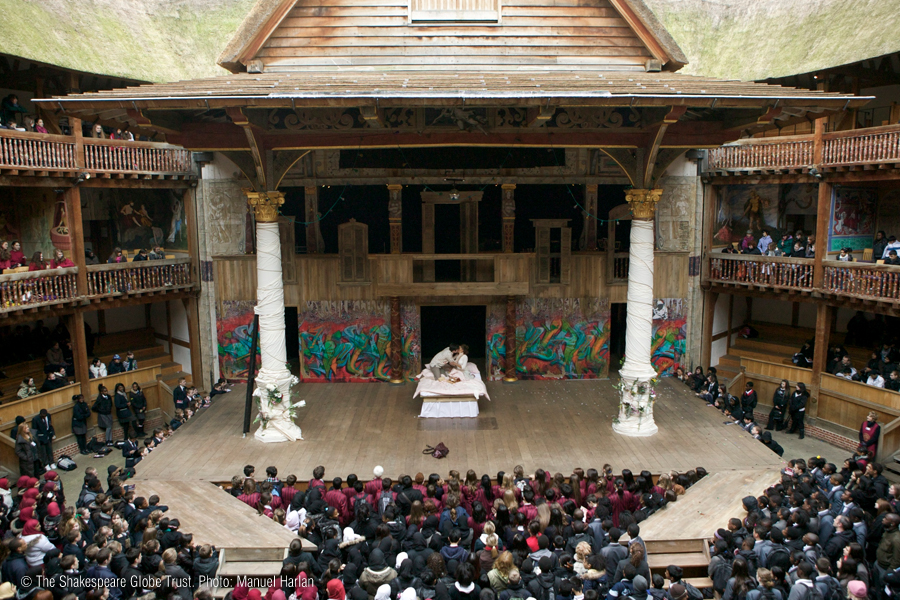
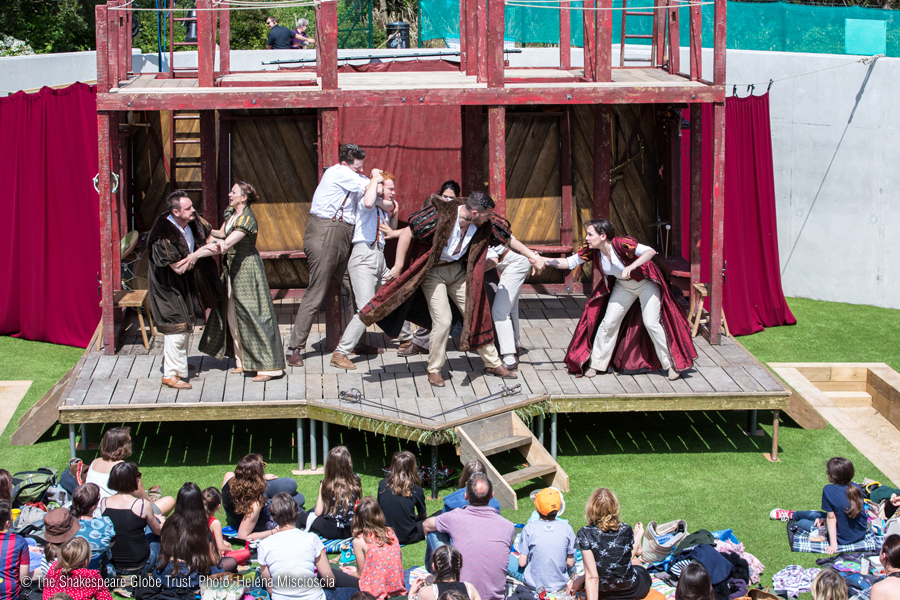
Questions to consider:
- Which one of these images shows the stage at the Globe? Why do they think this?
- What does a set designer at the Globe need to bear in mind? What is and isn’t possible?
- What are the challenges and opportunities of working with different layouts?
N.B. Comments might include the following, and this discussion will help you to ascertain students’ prior knowledge and could govern your choice of subsequent activities. The activities in ‘Enter the Players’ and the linked factsheets will support students’ learning in all of the following areas:
- set designs in Shakespeare’s times were not elaborate
- however, various special effects and the areas above and below the stage were used in imaginative ways
- benefits and limitations of apron stage v. proscenium arch
- the idea of hearing rather than watching a play
- how much the stage should change throughout the performance and how much will stay the same
- technical and financial implications of elaborate staging
- the importance of lighting/the fact that the Globe is open air and many performances take place in the daytime
- the clues about time and place provided within the language
- stage extensions can be added at the Globe
Enter the Players: Group Tasks
1) Staging a play at the Globe
In this video (2015.playingshakespeare.org/week-by-week/142), Globe director Bill Buckhurst speaks about the atmosphere at the Globe and the factors that contribute to this. Students could make notes in their Student Booklet in answer to the questions:
- How does Bill Buckhurst describe the general atmosphere at the Globe?
- What is it about the theatre space that creates this atmosphere?
The following quotation by Fiona Banks focuses more specifically on setting the scene and can be displayed to students on the ‘Words, Words, Words’ PowerPoint. This is available in the Downloads section at the bottom of this page and also in the Student Booklet.
'In the original Globe theatre, there would have been little in terms of elaborate set design and props, although stage effects were often used. The back of the stage was painted, as were the heavens and the pillars, but there was no particular set that changed with each play. Shakespeare uses language to set the scene for his audience and to ensure they have all the information they need about what is taking place on stage.'
Students could read this quotation and then re-read the last sentence, speculating about exactly what she means, i.e. ‘How does Shakespeare use language to set the scene?’ and ‘How does Shakespeare use language to provide the audience with all the information they need?’ Establishing these two questions and beginning to speculate about possible answers will lead effectively into the next activity.
2) Text detectives: setting the scene
Included in the Student Booklet is an extract from Act 5 Scene 1 lines 32-86, in which Romeo visits the Apothecary to buy poison. Students should read the extract closely in groups and highlight:
- where and when Shakespeare is setting the scene
- the information Shakespeare gives us about the appearance of the shop and its owner
- what the dialogue tells us about characters’ actions and reactions, or props that are important in the scene
Students should annotate the text with their findings. In the feedback, draw attention to how much Shakespeare communicates to the actors and audience through the dialogue itself.
ACT V SCENE 1. – (lines 32-86)
ROMEO:
No matter. Get thee gone,
And hire those horses. I’ll be with thee straight.
[Exit Balthasar.]
Well, Juliet, I will lie with thee tonight.
Let’s see for means. O mischief, thou art swift
To enter in the thoughts of desperate men.
I do remember an apothecary,
And hereabouts ‘a dwells, which late I noted,
In tattered weeds, with overwhelming brows,
Culling of simples. Meagre were his looks,
Sharp misery had worn him to the bones,
And in his needy shop a tortoise hung,
An alligator stuffed, and other skins
Of ill-shaped fishes; and about his shelves
A beggarly account of empty boxes,
Green earthen pots, bladders and musty seeds,
Remnants of packthread and old cakes of roses
Were thinly scattered to make up a show.
Noting this penury, to myself I said
‘An if a man did need a poison now,
Whose sale is present death in Mantua,
Here lies a caitiff wretch would sell it him’.
O, this same thought did but forerun my need,
And this same needy man must sell it me.
As I remember, this should be the house.
Being holiday, the beggar’s shop is shut.
What, ho, apothecary!
Enter Apothecary.
APOTHECARY: Who calls so loud?
ROMEO: Come hither, man. I see that thou art poor.
Hold, there is forty ducats. Let me have
A dram of poison, such soon-speeding gear
As will disperse itself through all my veins,
That the life-weary taker may fall dead,
And that the trunk may be discharged of breath
As violently as hasty powder fired
Doth hurry from the fatal cannon’s womb.
APOTHECARY: Such mortal drugs I have, but Mantua’s law
Is death to any he that utters them.
ROMEO: Art thou so bare and full of wretchedness,
And fearest to die? Famine is in thy cheeks,
Need and oppression starveth in thy eyes,
Contempt and beggary hangs upon thy back,
The world is not thy friend, nor the world’s law;
The world affords no law to make thee rich,
Then be not poor, but break it and take this.
APOTHECARY: My poverty but not my will consents.
ROMEO: I pay thy poverty and not thy will.
APOTHECARY: Put this in any liquid thing you will
And drink it off; and if you had the strength
Of twenty men, it would dispatch you straight.
ROMEO: There is thy gold, worse poison to men’s souls,
Doing more murder in this loathsome world
Than these poor compounds that thou mayst not sell.
I sell thee poison; thou hast sold me none.
Farewell, buy food, and get thyself in flesh.
[Exit Apothecary.]
Come, cordial and not poison, go with me
To Juliet’s grave, for there must I use thee.
3) A change of scene
Watch the footage of the first minute or so of this Globe production starring Jade Anouka as Juliet and Will Featherstone as Romeo.
Students could focus on how the Globe space can be transformed to give the impression of different locations. In this extract, the scene changes from a brawl in the streets, to the Prince’s words taking place afterwards at a press conference. Ask students to identify the features that are used to achieve such effects, e.g. props, sound effects, music, choreography, use of different areas of the stage and sometimes other special effects. Now ask students to consider how they might plan the following scene change: from an outdoor setting where Benvolio, Mercutio and Romeo meet before the ball, to inside the Capulets’ home for the party in Act 1 Scene 5. Students can make notes on these topics in the relevant Student Booklet page.
4) Creative brief: set design
Assign students the task of producing a set design for their own production of Romeo and Juliet. The brief and stage template for this task can be found in the Downloads section at the bottom of this page. Here are Isla's Top Tips:
- Think about the scale. The scale we always work in is 1:25, so you have to think about the design you do being 25 times bigger in reality.
- Designing a set isn’t just about creating a world, it’s also important to consider how the set can support the telling of the story.
- Consider the use of space and how the actors move around that space, including where their entrances and exits are.
- Think about your audience and how your set will work for them. Think about what the audience’s relationship to the actors is and importantly what their sightlines are - you don't want to build something huge that half the audience can't see through!
- What are the practicalities of your design. You need to plan everything from materials to colour schemes etc. Also, because you are designing outside you need to consider the bad weather conditions.
Exeunt: Closing Questions for Students
What are the factors to bear in mind when staging a production at Shakespeare’s Globe?
What impact have these factors had on my set design?
Which feature of my set design am I most proud of and why?
Suggested plenary activity…
Students should choose one detail from their set design, and write 50 words about its importance.
Asides: Further Resources
- Students will find fact sheets about theatres in Shakespeare’s time on the Globe’s Discovery Space: shakespearesglobe.com/discovery-space/fact-sheets
- Students could draw, photograph or find an image to accompany their 50 words in the ‘Suggested plenary activity’, and the resulting pieces of work could form a display.
- An apothecary was someone who made and prescribed medicine, similar to a chemist today. Apothecaries also sold spices, plants, oils, chemicals, and the ingredients for cosmetics and perfumes. It was against the law for them to sell poison. Sometimes priests or monks treated poor people for free, using similar medicines; in Romeo and Juliet, Friar Laurence clearly makes herbal medicines.
Epilogue: Teacher's Note
The ‘Creative brief – set design’ activity could be used as an assessment task. Students could be asked to write a detailed commentary to accompany their design.
Key Questions for Students:
Can I identify some of the connotations of a character’s costume and what it suggests to us about that character?
Can I think creatively about how I would dress one of the characters from Romeo and Juliet and why?
Key words: characters, connotations, cosmetics, costume, symbolism, wardrobe, wigs
Prologue: Opening Discussion
Display the famous Frank Bernard Dicksee painting of Romeo and Juliet. From which part of the play do students think it comes and why? Then ask students to work in pairs, analysing the painting in detail and recording their thoughts in the Student Booklet.
In each pair, Partner A should focus on position, posture and facial expression. Partner B should focus on the setting, colours and costume. Students could annotate the image to show the connotations of the things they have picked out. Share with students that this painting can be found in Southampton City Art Gallery, and that it was voted the most romantic painting in Britain in a 2012 Art Fund poll. Take feedback.
Enter the Players: Group Tasks
1) Wigs, hair and make-up
Students could be shown the interview with Pam Humpage – Head of Wigs, Hair and Make-up at Shakespeare’s Globe Theatre: 2013.playingshakespeare.org/week-by-week/165.
Students should answer the following questions found in the Student Booklet:
- Who does Pam work closely with initially when she is creating a wig?
- Describe the process by which a wig is made for one of the actors.
- Give an example of how the production can have an effect on the initial designs.
- Who influences the designs Pam comes up with?
- Why does Pam say it’s important to see other make-up artists’ work?
- What are the three challenges about working at the Globe that Pam mentions?
- “It was very messy and we had to do a massive clean-up at the end of every show.” Which production is Pam describing here and why was it so messy?
2) Dressing different characters
Students are shown twelve images of characters taken from two different productions of Romeo and Juliet. These can be displayed using the Costumes PowerPoint, available in the Downloads section at the bottom of this page. In pairs, students could:
- first of all, try to group the images by production
- next, try to pair the images by character (Juliet, Mercutio, Tybalt, Romeo, Nurse, Prince)
- notice key similarities and differences between the costumes
- consider the importance of the characters’ costumes and general appearance in conveying particular ideas about them to the audience
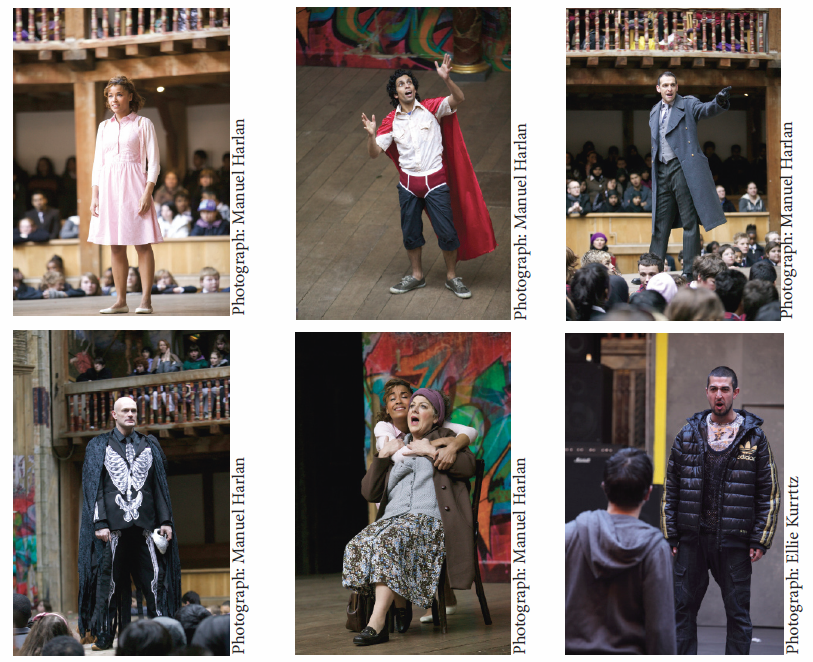
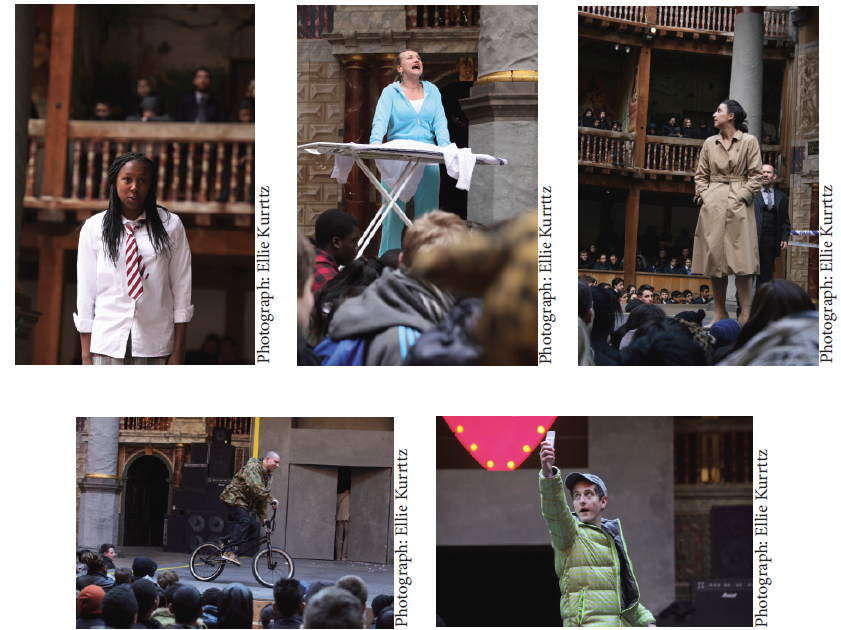
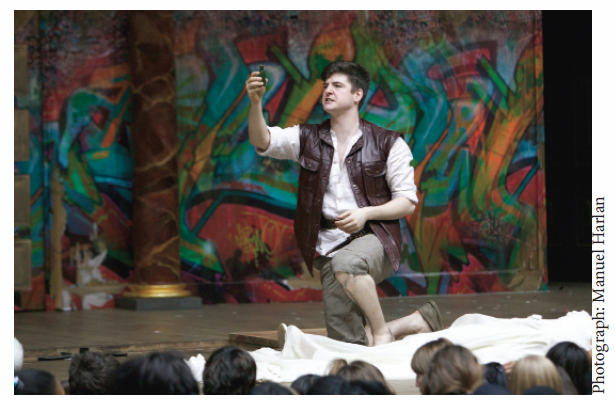
3) Fabric swatches
Provide groups of 3 or 4 with some different textile swatches (e.g. velvet, muslin, organza, silk, hessian) and/or swatches of different colours (e.g. red, black, white, blue, purple). Ask students to consider the connotations and symbolism of the fabrics and colours. Take feedback.
4) Creative brief: costumes
Students should make notes in pairs on the Dramatis Personae sheet about the costumes of the different characters: colours, style, fabrics, number of costume changes, details of hats, shoes, etc. Now set to work individually on producing annotated drawings for one of the character’s costumes. You can download a costume brief and costume templates in the Downloads section of this page. Students' annotations should include details of the reasons behind their choices (i.e. connotations, symbolism, quotations that inspired them). Here are Isla's Top Tips:
- Consider how the actor will move in your costume and whether they can be active in it or not.
- You need to consider the character you are designing for and think about their age, gender, background, shape, height etc. This includes thinking about how characters relate to each other, so think of them in the context of the rest of the company.
- Remember the details of your character, as this will tell you how they might use their costume. For instance: is their hair up or down? What kind of shoes do they wear?
- Try to make sure your drawing is really clear so that someone could actually make it. To help with this you should include notes describing what materials you will use and any other details.
- You need to think about the time period you are setting the play in as this will also help you with the period of your costume. The audience will often get a better understanding of time period through costume than through set.
Exeunt: Closing Questions for Students
Why is costume so important?
How would I dress one of the characters from Romeo and Juliet and why?
Would there be costume changes and, if so, what might the effect of these be?
What about wigs and make-up?
Suggested plenary activity…
Take pictures of some work in progress (Creative brief: costume) and display them. One or two students share their designs with the class and class members ask questions about the reasoning behind key decisions.
Asides: Further Resources
- Here is a quiz about clothing in Elizabethan times for students to try, which is available in the Student Booklet. The answers are included in the Teachers' Guide:
- The quantity of material used in your clothing was a sign of your wealth.
- Natural pigments like berries and beetles were used to dye clothes and there was always a risk that these colours would run in the rain.
- Only women wore frocks.
- Gaskins and slops were two different styles of loose-fitting trousers.
- Clothes were rarely washed in Shakespeare’s time.
- Male actors often wore high heeled shoes when playing women on stage.
- Married women kept their heads covered.
- A rebato was another name for a codpiece.
- Doublet and hose was a popular fashion among the lower classes in Shakespeare's time.
- At the official opening of Shakespeare's Globe, actress Jane Lapotaire arrived dressed as Queen Elizabeth I wearing a dress with 1,400 pearls sewn on to it. It took two people an hour and a half to dress her.
- As an extension activity, students could research costumes worn by the character they chose in a range of different productions.
- A fact sheet about costumes at the Globe can be found here: shakespearesglobe.com/uploads/files/2014/01/costumes_cosmetics.pdf
- Dr Farah Karim-Cooper, Head of Higher Education and Research at Shakespeare’s Globe, has conducted extensive research into the cosmetics used in the theatre in Shakespeare’s time. Her book Cosmetics in Shakespearean and Renaissance Drama includes cosmetic recipes from early modern printed books. A short video narrated by Dr Karim-Cooper showing Pam Humpage applying Elizabethan make-up can be found here: youtube.com/watch?v=-f8zeqmUD2Y#t=63.
- As an extension activity, students could research costumes worn by the character they chose for their creative brief activity in a range of different productions.
Epilogue: Teacher's Note
The ‘Creative brief – costume’ activity would work well as an assessment task. Students could be asked to write a detailed commentary to accompany their design.
Key Questions for Students:
Can I identify the purpose and features of a theatre review?
Can I plan and draft my own theatre review making effective use of these features?
Key words: adjective, adverb, audience, purpose, review, rhetorical question
Prologue: Opening Discussion
Collect a number of theatre reviews from newspapers and distribute them around the class. Students should highlight all the adjectives they find and share some examples. They should try to pick out if they can:
- an adjective used to describe an actor’s appearance
- an adjective used to describe an actor’s performance
- an adjective used to describe another feature, e.g. music, costume
- an adjective used to describe the production or the reviewer’s experience overall
- a very positive adjective
- an adjective that is more critical of the play or an aspect of it
Students should then record their results in the Student Booklet. Adjectives are just one way that a reviewer can express their opinions. By way of an extension question, students could be asked to identify other techniques used.
Enter the Players: Group Tasks
1) What makes a good review? I
Students can watch clips of reviewer Matt Trueman talking about reviewing a play (2015.playingshakespeare.org/week-by-week/154) and writing a review (2015.playingshakespeare.org/week-by-week). Ask students to draw out success criteria and any other helpful tips.
2) What makes a good review? II
Share a well-written recent theatre or film review of Romeo and Juliet with students, e.g. yorkshirepost.co.uk or nytimes.com
There are many activities you can do with such a text to support students in their own reading and review-writing skills, e.g.
- Establish the audience and purpose for this text and evaluate its effectiveness in addressing that audience and achieving its purpose.
- Analyse the overall structure, identifying the topic of each paragraph and how the overall argument about the film’s quality is constructed.
- Model reading a paragraph together, guide students through analysis of another paragraph and then give small groups a paragraph each to analyse.
- Highlight techniques such as adjectives and adverbs, alliteration, rhetorical question and modern cultural references, and annotate with comments about their effect on the reader
3) Creative brief – review
Students could write a review of a film version of the play (or a stage production if they have seen one). Encourage students to incorporate the advice and ideas they have learned about reviewing, and support students through the composition process from note-taking through drafting and redrafting to finally proofreading their reviews. A reviewing brief can be found in the Downloads section. Students could devise a set of success criteria for their reviews based on the brief, the top tips and what they learned from the newspaper reviews. Here are some Top Tips for students writing a review:
- As a guide, a newspaper review is generally about 300-500 words long.
- Read a theatre review. It doesn’t need to be of the same play, but see how other reviewers write.
- Try to avoid saying something was ‘good’ or ‘bad’. Explain what you saw and heard and explain the impact it had.
- Always give reasons to justify and explain your thoughts and opinions. Eg, avoid saying something was ‘effective’, instead explain what you saw and what the effect was on the scene, on the character, on the plot or on you.
- Shakespeare’s stories are generally so well known that the story itself is never really the topic of a review, it’s how the story is told that makes every performance different.
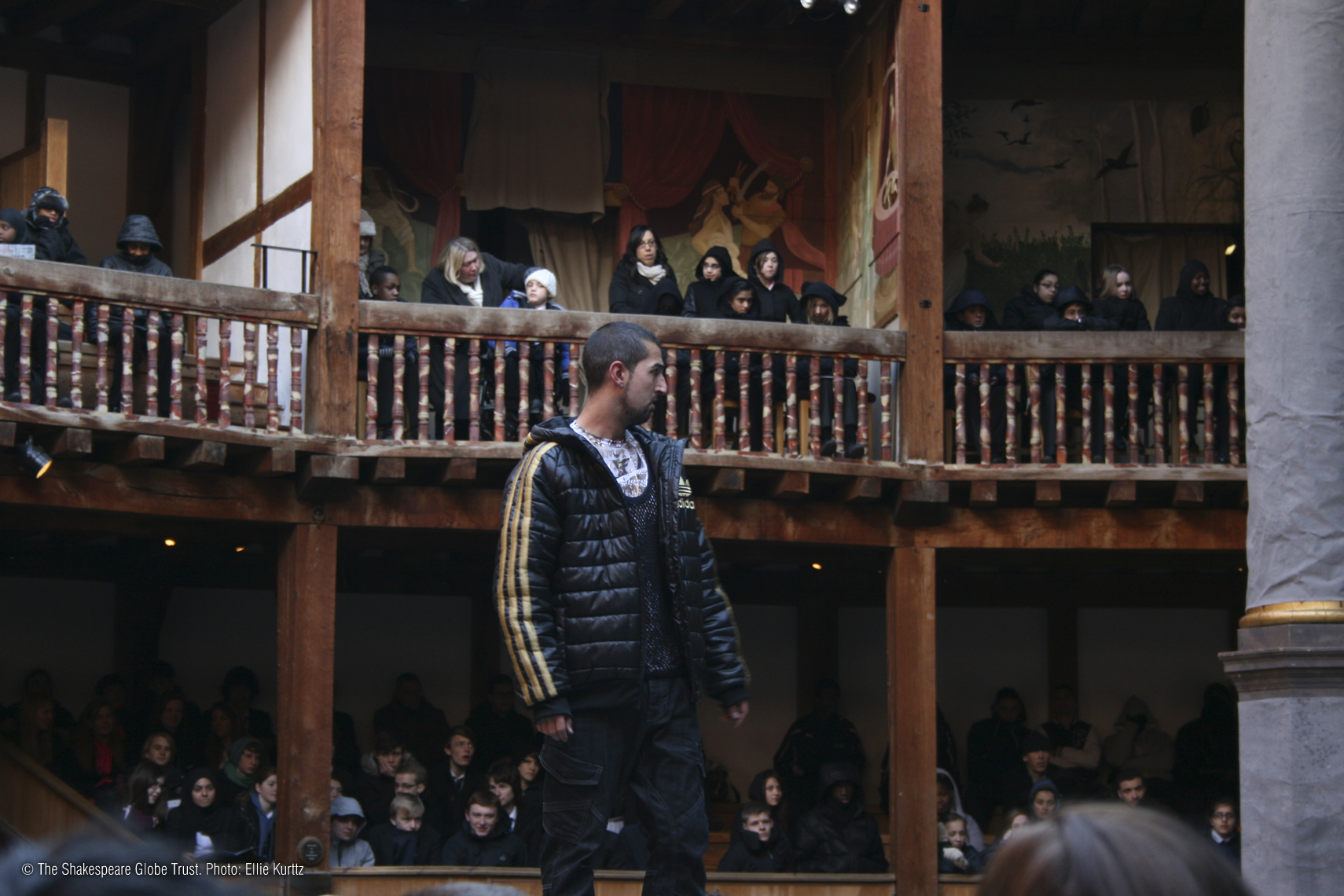
Exeunt: Closing Questions for Students
To what extent have I incorporated the features of a good review into my own writing?
Have I been observant, clear and honest in my reviewing?
What else could I do to improve my review writing?
Suggested plenary activity:
Self or peer assessment of draft reviews against the success criteria established with the class earlier.
Aside: Further Resource
- Students could find reviews of a number of different productions of Romeo and Juliet, or find more than one review of the same production to compare different critics’ views. Sample reviews could be displayed and annotated to highlight key features.
Epilogue: Teacher's Note
The ‘Creative brief – review’ activity would work well as an end-of-unit assessment task. Students could also collate all of their creative brief work (moodboard, set design, costume, review) into a portfolio for assessment. All assessment tasks can be collated in the ‘My Creative Folio’ section at the end of the Student Booklet.
